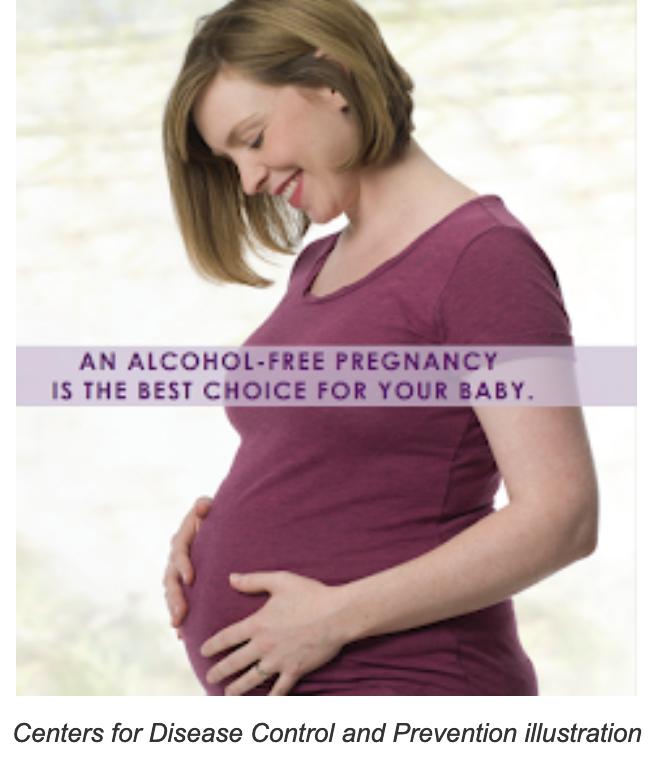Drinking while pregnant can have long-lasting effects on children, but almost 1/2 of pregnant Kentuckians report consuming alcohol

“Studies have estimated that fetal alcohol spectrum disorders, or FASD, affect between 1 and 5 percent of the population, though experts suspect the prevalence is even higher,” Yasinski reports.
The FASD United Policy and Training Center website says FASD is the “most commonly known cause of developmental disabilities in the United States,” and recent research shows up to one in 20 first graders have a disability from it.
Almost half of Kentucky women with a recent live birth consumed alcohol during the three months before pregnancy. The figure was 48.7% in 2019, according to the America’s Health Rankings report from the United Health Foundation. The national rate was even worse, 56.7%.
It wasn’t until the early 1970s that researchers found a pattern among babies born to mothers with severe alcohol-use disorders, including hallmark facial features such as a smooth upper lip, a small head, and a flat nasal bridge. These features were generally accompanied by a variety of lifelong mental and physical challenges such as learning disabilities, difficulty reasoning, growth deficiencies, and heart and kidney problems,” Yasinski reports.
Since then, researchers have found that prenatal alcohol exposure can disrupt development of the brain and body even without affecting the face, and include a broad range of conditions that are often inconsistent from one patient to another. Yasinski also delves into the details of how FASD changes the brain.
The FASD center says people with the disorder often have difficulty learning and remembering, understanding and following directions, shifting attention, controlling emotions and impulsivity, communicating and socializing, and performing daily life skills. It says FASD cases are seriously under-diagnosed and often hard to distinguish from other developmental disorders.
Further, Yasinski reports that diagnosis requires complex tests and treatments that, due to limited resources and awareness, many patients never get.
“Alcohol affects the brain in different ways, depending on when the brain is exposed in pregnancy and how much it’s exposed, and what else is going on, like nutritional factors, genetic factors, other things about the mom and the fetus,” Jeffrey Wozniak, a neurobehavioral development researcher at the University of Minnesota, told Yasinski. “So there’s a lot of variety in terms of the brain effects.”
According to Kentucky’s 2020 births report from the Public Health Neonatal Abstinence Syndrome Reporting Registry, “Alcohol use was reported by mothers of 4.8% of infants with NAS in Kentucky, which may be lower than the actual rate of use.”
Centers for Disease Control and Prevention data show that in 2018-20, 13.5% of pregnant U.S. adults reported that they were currently drinking and 5.2% reported they had engaged in binge drinking.
Many women drink without knowing they are pregnant, and that harm a fetus. About half of all U.S. pregnancies are unintended, and most women don’t know they are pregnant until four to six weeks into the pregnancy.
While binge drinking and regular heavy drinking put a fetus at the greatest risk for sever problems, even lesser amounts can also cause damage, says the National Institute on Alcohol Abuse and Alcoholism.
“In fact, there is no known safe level of alcohol consumption during pregnancy” says the institute.
The good news is that in the early 2000s, “Studies started to show that targeted therapies could help people who were prenatally exposed to alcohol,” Yasinski reports.
For example, Julie Kable, a neurodevelopmental exposure researcher at Emory University in Atlanta, told Yasinski that she and her team found with the CDC that offering adaptive support helped people with FASD better learn and understand math. Yasinski says researchers have also found ways to help people with FASD with executive function and decision making.
Kanle told Yasinski, “No longer could we allow pediatricians to say, Well, why should I diagnose it when there’s nothing we can do about it?”
But Yasinski reports that the U.S. has too few places that can diagnoise FASD, “and some states don’t even have a single FASD diagnostic center. Since diagnosis requires comprehensive evaluations, the centers that do exist have limited capacity to complete them. Many will only see patients who they know were very likely to have been exposed to alcohol in utero, which accounts for a fraction of those believed to be affected.”
She adds,, “While most experts agree on the basic characteristics of FASD, there are also minor differences in diagnostic criteria between states, countries, and clinics, with slightly different cutoffs.” And this, she reports “can create challenges for researchers working to build large data sets, but it also has more immediate impact.” For example, one FASD specialist told her that individuals with FASD in some states don’t qualify for disability services because ” the CDC only has consistent diagnostic criteria for fetal alcohol syndrome, not the whole spectrum of disorders.”
Some in Congress are working to provide resources for screening, research and other supportive services for people with FASD, in a bill called the FASD Respect Act. The FASD United Policy and Training Center says a new version of this bill is to be introduced.
Susan Shepard Carlson, who was a district court judge and first lady of Minnesota, told Yasinski that she is advocating for this bill largely because she realized in 1997 that a many children coming through the courts “had the same kind of profile [as] someone with FASD . . . but we weren’t really looking at the underlying cause.”
Because of this, Carlson convened a task force that led to the state funding FASD research and treatment. “The court was able to screen children suspected of having an undiagnosed FASD, and she says about 25 percent of the kids they chose to screen did have an undiagnosed disorder,” writes Yasinski.
Kable told Yasinski, “It’s really important to know that we can still have dramatic differences in the developmental outcome of these children, if we get them recognized, and get them services as early as possible.”
Information for this story was also gathered by Melissa Patrick of Kentucky Health News.
